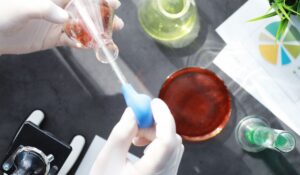Does Methylone Show Up on a Drug Test?
Methylone is a powerful stimulant often found in “bath salts.” People may use it for its short-term feeling of euphoria, but it can also cause dangerous side effects. Because it’s a synthetic cathinone, it’s similar to drugs like amphetamine and MDMA (ecstasy). If you or someone you know is in recovery, understanding how methylone affects the body — and whether it shows up on a drug test — is important.
At Lynk Diagnostics, we specialize in accurate and reliable drug testing for rehab facilities. Our tests are medically reviewed and built to help patients, treatment centers, and healthcare providers make informed choices.
What Is Methylone?
Methylone, also known as 3,4-methylenedioxy-N-methylcathinone, is a synthetic stimulant related to cathinone, a natural compound found in the khat plant. It affects brain chemistry in ways that boost energy, mood, and alertness — similar to amphetamine or methamphetamine.
Street Names for Methylone
- Bath salts
- Explosion
- Blow
- Cloud 9
- White Lightning
People might think it’s a harmless “party drug,” but methylone has serious risks and can lead to addiction, withdrawal, and long-term mental health issues.
How Does Methylone Work in the Body?
Methylone changes the way your brain’s neurotransmitters — like dopamine and serotonin — work. These chemicals control mood, pleasure, and motivation. When methylone floods the brain with dopamine, users feel euphoria and high energy.
However, these effects are short-lived, and the brain quickly becomes depleted. This leads to crashes, anxiety, and sometimes psychosis or confusion.
Effects on the Body
- Increased heart rate
- High blood pressure
- Sweating and shaking
- Insomnia
- Loss of appetite
- Rapid mood changes
- Muscle tension or pain
Because methylone is a stimulant, it can put heavy stress on the heart, liver, and nervous system.
Is Methylone Legal?
No. The Drug Enforcement Administration (DEA) classifies methylone as a Schedule I controlled substance under U.S. federal law. This means it has no accepted medical use and a high potential for abuse.
Possessing, selling, or using methylone can lead to serious legal consequences.
Does Methylone Show Up on a Drug Test?
Yes — methylone can show up on a drug test, especially advanced lab-based testing like those used at Lynk Diagnostics.
While some standard tests may not detect methylone specifically, modern forensic toxicology methods can. Because methylone is structurally similar to amphetamine, it may also trigger false positives on some rapid urine tests.
Types of Drug Tests That Can Detect Methylone
1. Urine Test
Urine testing is the most common method. Methylone and its metabolites (the chemical byproducts that remain after your body processes the drug) can usually be detected 1–3 days after use.
2. Blood Test
A blood test can show methylone for a shorter window, usually up to 24 hours after last use. Blood testing helps in cases of medical emergencies or forensic investigations.
3. Hair Test
Hair tests can detect methylone for up to 90 days after use, depending on the length of the hair sample. This is often used for long-term monitoring in rehab programs or workplaces.
4. Saliva Test
A saliva test may detect methylone for up to 48 hours, though it’s less common in clinical or rehab settings.
Factors That Affect Detection
The time methylone stays in the body depends on several things:
- Dose: Higher doses take longer to clear.
- Metabolism: Faster metabolism means quicker elimination.
- Liver function: A weak liver may slow detox.
- Hydration: More fluids can help flush out the metabolites.
- Frequency of use: Regular users will have longer detection windows.
What Does Methylone Feel Like?
Methylone produces feelings of euphoria, increased energy, and emotional warmth. Many users compare it to MDMA.
Common Effects Include:
- Boosted confidence
- Increased talkativeness
- Rapid heart rate and sweating
- Trouble sleeping
- Heightened senses
While it might feel pleasant at first, repeated use can damage mental health and cause dependence.
Side Effects and Health Risks
Methylone can strain the heart and nervous system, especially at high doses. Some users experience severe side effects even after one use.
Short-Term Side Effects
- Rapid heart rate
- High blood pressure
- Anxiety or panic attacks
- Nausea
- Chest pain
Long-Term Side Effects
- Memory and cognition problems
- Insomnia and fatigue
- Depression or anxiety
- Heart and liver damage
- Addiction and withdrawal symptoms
If someone stops using methylone suddenly, withdrawal symptoms can appear, including depression, low energy, and irritability.
Methylone vs. Bath Salts
Methylone is one of several chemicals found in synthetic bath salts, which are man-made stimulants designed to mimic drugs like cocaine or amphetamine.
Although the packaging might say “not for human consumption,” these products are often abused for their psychoactive effects. Many bath salts are illegal because of their link to psychosis, addiction, and even death.
How Long Does Methylone Stay in the System?
On average, methylone stays in the body for 1 to 3 days, depending on how much is used. Chronic users may test positive longer because the drug builds up in fat and tissue.
Breakdown by test type:
- Urine: Up to 3 days
- Blood: Up to 24 hours
- Saliva: Up to 2 days
- Hair: Up to 90 days
Why Accurate Testing Matters
For rehab centers and healthcare providers, accurate drug testing is key to supporting recovery. False negatives or false positives can interfere with treatment plans.
At Lynk Diagnostics, all tests are medically reviewed to ensure accuracy and reliability. Our team uses advanced chromatography and mass spectrometry techniques to detect even trace amounts of synthetic stimulants like methylone.
The Role of the Liver and Pharmacology
The liver plays a major role in breaking down methylone. Pharmacology studies show that methylone converts into multiple metabolites, which are then passed out through urine. People with liver disease or poor liver health may process the drug more slowly, extending detection times.
The Connection Between Methylone and Addiction
Like many stimulants, methylone can be highly addictive. Over time, the brain becomes dependent on the rush of dopamine, leading to cravings and withdrawal when not using.
Signs of Methylone Addiction
- Needing higher doses for the same effect
- Ignoring responsibilities or health
- Mood swings and irritability
- Trouble sleeping
- Craving the drug despite negative effects
If you or a loved one struggles with methylone use, testing and professional help can make recovery possible.
Lynk Diagnostics: Reliable Drug Testing for Rehab Facilities
At Lynk Diagnostics, we understand the importance of accurate results in addiction treatment. Our laboratory offers forensic testing and toxicology screening for substances like methylone, tapentadol, and other controlled drugs.
Our medically reviewed testing process helps ensure that each result supports both health and recovery. Whether testing urine, blood, or hair samples, we maintain strict quality control and confidentiality.
Understanding Withdrawal and Recovery
Stopping methylone can cause withdrawal symptoms similar to other stimulants. These include fatigue, sadness, loss of motivation, and cognitive fog. Recovery requires time, support, and a strong medical team.
Detox programs and therapy can help restore balance to the central nervous system and improve cognition. Many people also work on rebuilding physical health — including blood pressure, heart rate, and emotional well-being.
The Importance of Medically Reviewed Results
A medically reviewed drug test ensures accuracy. Each positive result is confirmed by expert toxicologists using precise lab instruments. This is especially important when distinguishing substances with similar chemical structures, such as methylone and amphetamine.
Final Thoughts
Yes, methylone can show up on a drug test. With today’s advanced laboratory methods, substances like methylone are easier to detect than ever before.
Because it affects both mental health and physical systems like the heart and liver, proper monitoring and testing are crucial.
At Lynk Diagnostics, we provide accurate and confidential drug testing for rehab centers, ensuring every result is medically reviewed and trustworthy.
FAQs About Methylone and Drug Testing
Does methylone show up on a urine drug test?
Yes. Methylone can appear on a urine drug test for up to 3 days after use, depending on the person’s health, dose, and metabolism.
Can methylone cause a false positive?
Yes. Because methylone’s chemistry is similar to amphetamine, it can sometimes trigger a false positive on standard screening tests.
How dangerous is methylone use?
Methylone can raise blood pressure, increase heart rate, and cause serious side effects like anxiety, paranoia, and even heart problems.
How long does methylone stay in your system?
Methylone typically stays in the body for 1–3 days, but this can vary based on liver health and frequency of use.
Where can I get accurate drug testing for methylone?
You can trust Lynk Diagnostics, a professional drug testing center dedicated to supporting rehab facilities and ensuring accurate, medically reviewed results.








